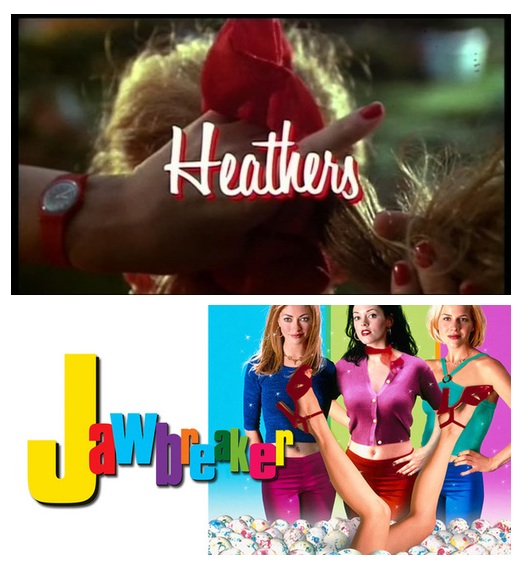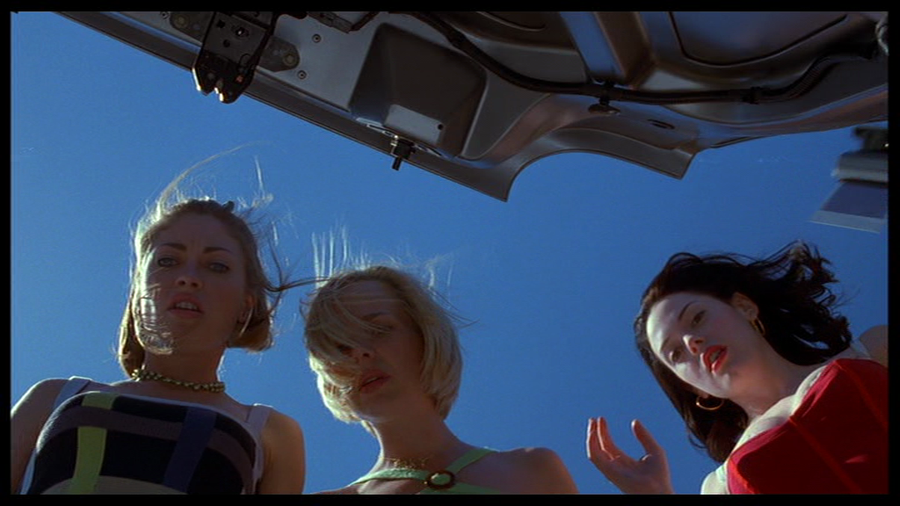
Jawbreaker
Directed by: Darren Stein
USA, 1999
Heathers
Directed by: Michael Lehmann
USA, 1988
Discussion of Jawbreaker (1999) seems near impossible without some reference to Heathers (1988). The two films sit together along with their peers Carrie (1975), Mean Girls (2004), Clueless (1995) and others, in the film-genre high school lunch room. Jawbreaker holds only a critical 7% and audience 52% on rotten tomatoes to Heathers’ critical 95% and audience 81%. It would seem that, in the words of their lunch-mate Mean Girls “people are saying [Jawbreaker] is a less hot version of [Heathers].” Critics often lambast the ’99 comedy for ripping too directly from its ’88 counterpart, for being less intelligent, less humorous and unoriginal. But what are these types of comparative criticisms of these films appealing to? While the two certainly hold similar subjects there is a clear distinction in style and intention. Where Heathers discusses the structure of society Jawbreaker focuses on the spectacle that hides the sour intentions.
Both Jawbreaker and Heathers are black comedies that focus on popular young girls killed by their slightly-less-popular girlfriends. Heathers follows the story of Veronica (Winona Ryder), a begrudging member of the reining social clique before a romance with J.D. (Christian Slater) makes her a part of a killing spree whereby she discovers her own powers as woman. Eleven years later we have Darren Stein’s Jawbreaker (1999) about a group of girls who accidentally kill their friend, a high school sweetheart, during a birthday prank and subsequent cover-up and uncovering.

Jawbreaker’s writer/director Darren Stein isn’t shy in admitting that Heathers was in the back of his mind while working on the film, but he also mentions the influences of Carrie, Grease and Nightmare on Elm Street. Films which have their appeal rooted in their showmanship. Jawbreaker even speaks to it’s own circus tent aesthetic as it’s character Julie (Rebecca Gayheart) equates her former clique to a “side-show.” Nearly everything serves to fuels this side-show aesthetic; The characters, the situation, the colors pull the film along through the chaos of a pink lip-glossed funfair lined in lockers and prom announcements. The beautification montage of geek Fern Mayo (Judy Greere) into overnight popularity sensation Violette takes place in a spinning room of shinning faux-leather and swirling stripes. The entire production is bright red lipstick coated in 90s pop-rock counter culture complete with the occasional cartoon sound effect cut. Image drives this film.
Jawbreaker’s production designer Jerry Fleming is also credited for his work in both Crank (2006) and Crank: High Voltage (2009). These films’ visually absurd sensibility fuels their perversions and become the driving force within their narratives. By contrast Jon Huntman, production designer for Heathers– as well as The Holiday (2006), Something’s Gotta Give (2003) and French Kiss (1995)- has a visual style that doesn’t bend towards the extremes but serves to guide his films without overwhelming them.

Even the form of character development in the two films are remarkably different. Heathers is a story told from the inside looking out. The gaze is primarily on monocle wearing Veronica (Winona Ryder) as she scribbles frustration through childish handwriting into her journal. Her own handwriting only half as developed as the writing imitations she provides for her friends. Heathers seems less interested in the side-show and more interested in the deconstruction of society and coming-of-age through a dark and wit driven barrage of characters. A circus in it’s circumstances more than it’s style.
The Jawbreaker carnival procession spends it’s time drifting from character to character without the myopic focus on any particular individual. It uses this and plays it to extremes, not looking to form soft, rounded or even relatable characters. The sociopath prom-queen, the James Dean drama boyfriend, the shimmering braces and lumpy-sweater wearing geek- these are all clowns in the circus. These are characters who are not meant to have wells of depth, who are not meant to do more than fuel the spectacle.

Jawbreaker we know nothing of the decaying Liz character except through the postmortem hearsay of her friends and classmates. Jawbreaker opens through an admiring voice over from our token geek Fern Mayo who, with an almost creepy conviction, recounts her singular encounter with the accidentally killed prom-queen contender. Fern’s testimony of Liz’s personality could be called into question as the character openly admits that she “didn’t know Liz as much as she knew of her.” In one specific scene Fern proclaims to the school’s Ms. Sherwood (Carol Kane) that Liz “Purr” is the “cat’s meow” whereby the principal simply replies with a dismissive yet sympathetic “I’m sure she is.” Fern doesn’t know Liz anymore than we do. There is some evidence that Liz might have been a sweet girl. In Fern’s memory she helps pick up her school books, Julie (our reasonable and conflicted heroin) states the “Liz was the only one who meant anything to her.” But there is also evidence to the contrary. Julie’s new boyfriend Zack (Chad Christ) is quick to point out the cruelty of their group as it appeared on the outside. There isn’t a completely solidified image of what the dearly deceased was actually like.

In Heathers we do know something of the victims personality prior to their demise. Before the first death, Heather Chandler (Kim Walker) we are confronted with her living personality. We have the chance to experience her cruelty and glimpse into quiet moments of her own self recognition. In one notable scene Heather spits it at her own reflection after a potentially deplorable act. This- a telling mark of a human character.
None of this is to point at the superiority of either film but to highlight some of their overlooked differences. Ultimately both films end with a nod towards friendship being deeper than surface level as heroines team with geeks and escape the side-show. Cue teeny-bopper hit from any given decade.
– Adriene Lilly


